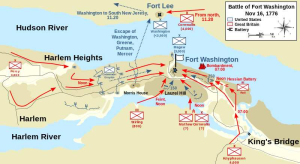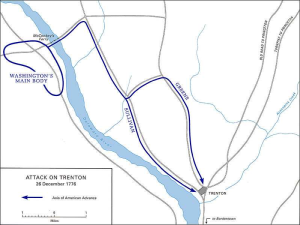From our Senior Deacon, Corey Kunde:
An oft overlooked aspect of the Revolutionary War was the real possibility of failure when still in its infancy. During the fall of 1776, the British Army pushed out a fledgling Continental Army from all of New York City. This included defeats of Bro. Gen. George Washington at White Plains, Fort Lee and Fort Washington (see battle map below).
After these defeats, the Continental Army fled across New Jersey and crossed into Pennsylvania to escape. Not only did these defeats result in the capture of thousands of men and materiel-morale was running on fumes. Men were deserting. A strategic city and harbor-New York-had been completely lost and doubts were creeping in about Washington’s ability to lead his men. In fact, Gen. Washington himself had written to his cousin that “I think the game is pretty near up.” Generally, the condition of the Continental Army in early December 1776 could be summed up as haggard and desperate.
While conditions were bleak, intelligence reports indicated Trenton as being occupied by three regiments of Hessian soldiers, totaling 1,500 men. In contrast, Gen. Washington had a force of 2,400 soldiers. In an effort to boost the cratered morale of his troops, Gen. Washington planned an attack on this Hessian force during Christmas of 1776 (December 25-26). Originally, this plan called for a three-pronged attack, including a diversionary engagement of a British garrison at Bordentown, New Jersey. However, approximately half of the planned force was unable to make the crossing from Pennsylvania. Fortunately, inadequate defensive positioning by the Hessian garrison, helpful citizenry and sound tactics mitigated this loss of manpower (see battle map below).
A primary function of this successful battle was proving the Continental Army could actually match the fighting prowess of a European land army. Thus, the most important achievement of this relatively small engagement was a badly needed morale boost. The practicality of capturing Hessian materiel and supplies provided additional support to the army.
This proved to be a pivotal point in the battle for America’s freedom from tyranny.

